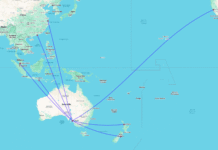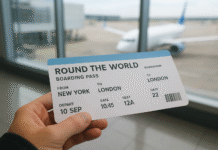Traveling from Australia? Here’s What You Need to Know About Flying to the Middle East, Europe, or the U.S. During Middle East Tensions

If you’re planning a trip from Australia to the Middle East, Europe, or the United States, you might be wondering if it’s safe to fly given recent news about conflicts in the Middle East. Some countries in that region have closed their airspaces due to ongoing tensions, particularly involving Israel, Iran, and neighboring areas. But don’t worry—here’s a straightforward guide to help you understand what’s happening and how it affects your travel plans, even if you’re not a geography expert.
What’s Happening in the Middle East

The Middle East is a region that includes countries like Iran, Iraq, Israel, Jordan, and Lebanon. Right now, some of these places are experiencing conflicts, which have led to temporary closures of their airspaces—the areas in the sky where planes fly. This is because of risks like missiles, drones, or navigation issues caused by GPS interference. These closures affect flights passing over or landing in these countries.
Is Flying Still Safe?
Good news: flying from Australia to the Middle East, Europe, or the U.S. is generally safe because airlines are taking extra precautions. Here’s why:
- Airlines Avoid Risky Areas: Airlines like Qantas, Emirates, and Qatar Airways are rerouting flights to avoid countries with closed or risky airspaces, such as Iran, Iraq, or Israel. Instead, they fly through safer areas like Saudi Arabia, Egypt, or even Asia (e.g., Singapore or Central Asian countries).
- Safety First: Airlines work with global aviation experts to monitor risks in real time. They use alternate routes to keep passengers safe, even if it means longer flights.
- Past Lessons Learned: Rare incidents, like planes being mistakenly shot down in conflict zones years ago, have led to stricter safety rules worldwide. Airlines now avoid risky areas altogether.
How Does This Affect Your Trip?
Here’s how these changes might impact your travel plans, depending on where you’re headed:
- To the Middle East (e.g., Dubai, Doha):
- Cities like Dubai (United Arab Emirates) and Doha (Qatar) are major stopover points for flights from Australia. These places have had brief airspace closures but are mostly open now.
- You might face delays or cancellations if tensions spike again, so check with your airline before you fly.
- To Europe (e.g., London, Paris):
- Many flights from Australia to Europe stop in Middle Eastern hubs or fly over the region. With some airspaces closed, airlines are taking detours, often through Asia (like Singapore) or other Middle Eastern countries (like Saudi Arabia).
- These detours can add a few hours to your flight. For example, Qantas’s Perth-to-London flight now stops in Singapore to avoid risky areas.
- To the U.S. (e.g., Los Angeles, New York):
- Most flights from Australia to the U.S. West Coast (like Los Angeles) go across the Pacific Ocean, so they’re not affected by Middle East issues.
- Flights to the U.S. East Coast (like New York) sometimes cross the Middle East. If so, airlines are rerouting to avoid trouble spots, which might make the trip longer.
What Are the Risks?
While flying is safe, there are a few things to keep in mind:
- Delays and Cancellations: Rerouting flights can lead to busier skies in safe areas, causing delays. For example, one Qantas flight to Paris had to turn back after 15 hours due to sudden airspace closures.
- Sudden Changes: The situation in the Middle East can change quickly. If tensions increase, more airspaces could close, affecting flights to or through the region.
- Navigation Issues: In some areas, GPS signals can be disrupted, but pilots are trained to handle this, and airlines avoid these zones.
Tips for a Smooth Trip
To make your travel experience as stress-free as possible, follow these simple steps:
- Check Your Flight: Visit your airline’s website or app (e.g., Qantas, Emirates) for updates on your flight’s status. You can also use sites like Flightradar24 to see where planes are flying.
- Book Flexible Tickets: Choose airlines that let you change or cancel your flight for free if plans change. Qatar Airways and others are offering this now.
- Get Travel Insurance: Buy insurance right after booking to cover delays, cancellations, or unexpected changes. Make sure it includes coverage for disruptions caused by conflicts.
- Pack for Delays: Bring essentials like snacks, a charger, and comfy clothes in case of long layovers or diversions.
- Avoid Risky Destinations: The Australian government advises against travel to places like Iran, Iraq, Israel, Syria, and Yemen. They also suggest skipping non-essential trips to Lebanon and Jordan. If you’re heading to Europe, consider flights that stop in Asia instead of the Middle East.
- Stay Updated: Check travel advisories from Smartraveller (Australia’s travel advice website) for the latest news on your destination.
Should You Cancel Your Trip?
There’s no need to cancel your plans just yet. Airlines are doing everything they can to keep flights safe, and most are offering options to rebook or get refunds if they cancel your flight. However, if you’re worried about traveling to the Middle East, talk to your airline about rerouting through Asia or other safer paths.
Final Thoughts
Flying from Australia to the Middle East, Europe, or the U.S. is still safe, thanks to airlines’ careful planning and detours around troubled areas. You might face longer flights or occasional delays, but the risks to your safety are very low. By staying informed, booking flexibly, and preparing for potential disruptions, you can travel with confidence. If you have a specific flight or destination in mind, contact your airline for the latest updates.




